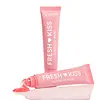What's inside
What's inside
 Key Ingredients
Key Ingredients

 Benefits
Benefits

 Ingredients Side-by-side
Ingredients Side-by-side

Bis-Behenyl/Isostearyl/Phytosteryl Dimer Dilinoleyl Dimer Dilinoleate
EmollientDiisostearyl Malate
EmollientPolyisobutene
Hydrogenated Polyisobutene
EmollientOctyldodecanol
EmollientCaprylic/Capric Triglyceride
MaskingPolyglyceryl-2 Triisostearate
EmulsifyingParaffin
PerfumingSilica Dimethyl Silylate
EmollientMicrocrystalline Wax
Emulsion StabilisingStearalkonium Hectorite
Gel FormingAroma
Propylene Carbonate
SolventTocopheryl Acetate
AntioxidantIsohexadecane
EmollientAspartame
Pentaerythrityl Tetra-Di-T-Butyl Hydroxyhydrocinnamate
AntioxidantTocopherol
AntioxidantEthylene/Propylene/Styrene Copolymer
Butylene/Ethylene/Styrene Copolymer
Phenoxyethanol
PreservativeSodium Hyaluronate
HumectantXanthan Gum
EmulsifyingAluminum Hydroxide
EmollientTripeptide-1
Skin ConditioningCI 77891
Cosmetic ColorantCI 19140
Cosmetic ColorantCI 15850
Cosmetic ColorantIron Oxides
Bis-Behenyl/Isostearyl/Phytosteryl Dimer Dilinoleyl Dimer Dilinoleate, Diisostearyl Malate, Polyisobutene, Hydrogenated Polyisobutene, Octyldodecanol, Caprylic/Capric Triglyceride, Polyglyceryl-2 Triisostearate, Paraffin, Silica Dimethyl Silylate, Microcrystalline Wax, Stearalkonium Hectorite, Aroma, Propylene Carbonate, Tocopheryl Acetate, Isohexadecane, Aspartame, Pentaerythrityl Tetra-Di-T-Butyl Hydroxyhydrocinnamate, Tocopherol, Ethylene/Propylene/Styrene Copolymer, Butylene/Ethylene/Styrene Copolymer, Phenoxyethanol, Sodium Hyaluronate, Xanthan Gum, Aluminum Hydroxide, Tripeptide-1, CI 77891, CI 19140, CI 15850, Iron Oxides
Polybutene
Octyldodecanol
EmollientPentaerythrityl Tetraisostearate
EmollientHydrogenated Polydecene
EmollientPalmitoyl Hexapeptide-12
Skin ConditioningCeramide Ng
Skin ConditioningAroma
Menthone Glycerin Acetal
RefreshingSilica Dimethyl Silylate
EmollientSqualane
EmollientCaprylic/Capric Triglyceride
MaskingHydrogenated Styrene/Isoprene Copolymer
C12-15 Alkyl Benzoate
AntimicrobialSimmondsia Chinensis Seed Oil
EmollientPhenoxyethanol
PreservativeFragaria Ananassa Seed Oil
AntioxidantRubus Idaeus Seed Oil
EmollientTocopherol
AntioxidantTribehenin
EmollientCaprylyl Glycol
EmollientEthylene/Propylene/Styrene Copolymer
Saccharin
MaskingEthylhexylglycerin
Skin ConditioningHexylene Glycol
EmulsifyingPEG-10 Phytosterol
EmulsifyingZingiber Officinale Root Extract
MaskingDiethylhexyl Syringylidenemalonate
Skin ProtectingButylene/Ethylene/Styrene Copolymer
Pentaerythrityl Tetra-Di-T-Butyl Hydroxyhydrocinnamate
AntioxidantPolybutene, Octyldodecanol, Pentaerythrityl Tetraisostearate, Hydrogenated Polydecene, Palmitoyl Hexapeptide-12, Ceramide Ng, Aroma, Menthone Glycerin Acetal, Silica Dimethyl Silylate, Squalane, Caprylic/Capric Triglyceride, Hydrogenated Styrene/Isoprene Copolymer, C12-15 Alkyl Benzoate, Simmondsia Chinensis Seed Oil, Phenoxyethanol, Fragaria Ananassa Seed Oil, Rubus Idaeus Seed Oil, Tocopherol, Tribehenin, Caprylyl Glycol, Ethylene/Propylene/Styrene Copolymer, Saccharin, Ethylhexylglycerin, Hexylene Glycol, PEG-10 Phytosterol, Zingiber Officinale Root Extract, Diethylhexyl Syringylidenemalonate, Butylene/Ethylene/Styrene Copolymer, Pentaerythrityl Tetra-Di-T-Butyl Hydroxyhydrocinnamate
 Reviews
Reviews

Ingredients Explained
These ingredients are found in both products.
Ingredients higher up in an ingredient list are typically present in a larger amount.
Aroma refers to an ingredient, or mixture of ingredients, that impart or mask a flavor.
The name is slightly confusing. This is because INCI associates aroma with flavor instead of smell.
Here is the official definition from the The International Cosmetic Ingredient Dictionary and Handbook:
“Aroma is a term for ingredient labeling used to identify that a product contains a material or combination of materials normally added to a cosmetic to produce or to mask a particular flavor.”
INCI shows the only purpose of aroma to be "flavouring".
However, due to regulation differences, some companies may use aroma in place of parfum.
In Canada, this ingredient only has to be listed in concentrations above 1%.
Learn more about AromaWe don't have a description for Butylene/Ethylene/Styrene Copolymer yet.
This ingredient is an emollient, solvent, and texture enhancer. It is considered a skin-softener by helping the skin prevent moisture loss.
It helps thicken a product's formula and makes it easier to spread by dissolving clumping compounds.
Caprylic Triglyceride is made by combining glycerin with coconut oil, forming a clear liquid.
While there is an assumption Caprylic Triglyceride can clog pores due to it being derived from coconut oil, there is no research supporting this.
Learn more about Caprylic/Capric TriglycerideWe don't have a description for Ethylene/Propylene/Styrene Copolymer yet.
Octyldodecanol is a fatty alcohol. It is primarily used to enhance the texture of products.
As an emulsifier, Octyldodecanol helps prevent the oils and waters from separating. It also prevents ingredients from creating foam when shaken.
Octyldodecanol is created by reducing fatty acid to an alcohol.
Due to its high molecular weight, it does not get absorbed into the skin.
Learn more about OctyldodecanolPentaerythrityl Tetra-Di-T-Butyl Hydroxyhydrocinnamate (long name, huh?) is a synthetic antioxidant.
It is used to help stabilize other antioxidants or prevent the color from changing in a product.
As an antioxidant, it helps fight free-radical molecules. Free-radical molecules are capable of damaging our cells and other genetic material. Thus, antioxidants may reduce the signs of aging.
This ingredient is oil-soluble.
Learn more about Pentaerythrityl Tetra-Di-T-Butyl HydroxyhydrocinnamatePhenoxyethanol is a preservative that has germicide, antimicrobial, and aromatic properties. Studies show that phenoxyethanol can prevent microbial growth. By itself, it has a scent that is similar to that of a rose.
It's often used in formulations along with Caprylyl Glycol to preserve the shelf life of products.
This silica is mainly used to thicken oils and suspend particles in oils. It is not water soluble.
According to the manufacturer, it:
The manufacturer also claims this ingredient to be useful in makeup.
In lipstick formulations, this ingredient improves color payoff, reduces pigment settling, and reduces oil bleeding. This ingredient also improves the grip of powder products such as dry shampoos.
Learn more about Silica Dimethyl SilylateTocopherol (also known as Vitamin E) is a common antioxidant used to help protect the skin from free-radicals and strengthen the skin barrier. It's also fat soluble - this means our skin is great at absorbing it.
Vitamin E also helps keep your natural skin lipids healthy. Your lipid skin barrier naturally consists of lipids, ceramides, and fatty acids. Vitamin E offers extra protection for your skin’s lipid barrier, keeping your skin healthy and nourished.
Another benefit is a bit of UV protection. Vitamin E helps reduce the damage caused by UVB rays. (It should not replace your sunscreen). Combining it with Vitamin C can decrease sunburned cells and hyperpigmentation after UV exposure.
You might have noticed Vitamin E + C often paired together. This is because it is great at stabilizing Vitamin C. Using the two together helps increase the effectiveness of both ingredients.
There are often claims that Vitamin E can reduce/prevent scarring, but these claims haven't been confirmed by scientific research.
Learn more about Tocopherol